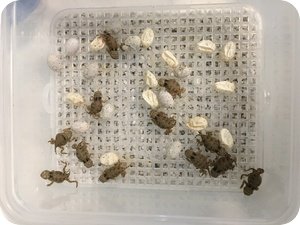Horned Lizards are Headed Back Out on the Range; Thanks to a San Antonio Zoo® Program Supported by the San Miguel Electric Cooperative
Print this Article | Send to Colleague
Horned Lizards are Headed Back Out on the Range; Thanks to a San Antonio Zoo® program that is Supported by the San Miguel Electric Cooperative
Thanks to San Antonio Zoo – and supporting organizations like the San Miguel Electric Cooperative (SMEC) – the Texas horned lizard may be making a comeback in central Texas. A benchmark of this project is now underway: the training of “sniffer dogs” to monitor and detect this beloved lizard in its natural habitat.
Threatened Species
If you’re like most Texans of a certain age, you’ve got memories of finding “buckets” of horned lizards in your youth. Not so much today, as this species – called Phrynosoma cornutum and commonly referred to as the “horny toad” – has declined or disappeared in many places in Texas since the late 1960s.
San Antonio Zoo’s Center for Conservation and Research is seeking to reverse this trend by producing large numbers of lizards in captivity and then releasing them into predetermined habitats that can support the species.
“Our goal is to re-establish viable horned lizard populations as part of a healthy native ecosystem and return this species to the landscape for the enjoyment of present and future generations,” said Dr. Andrew Gluesenkamp, director of conservation at San Antonio Zoo.
A Dog’s Day for the Lizard Population 
To monitor the newly released lizards, the zoo is taking a novel approach: using trained “sniffer dogs” to track site assessment, pre- and post-release management and population monitoring. In partnership with Chiron K9, it is embarking on a pilot lizard detection canine project. If successful, dogs will be sourced from animal shelters and trained to detect live horned lizards, as well as their eggshells, shed skin and scat pellets.
The first trained canine is ready to go – a Dutch Shepherd named Gren – who is a rescue dog that his trainer Chris says is “eager to get out into the field” to begin detecting the lizards. The inaugural lizard release is expected to take place by the end of the year.
The horned lizard – the state reptile of Texas – is threatened by a number of factors, including fragmentation and habitat loss, introduction of exotic grasses, pesticide use and the proliferation of red imported fire ants (which feed on the eggs). The zoo’s planned release habitats will ensure that these threats are minimally present. Potential properties for the first round of releases include tracts in Blanco and Kerr Counties and Center for Conservation and Research staff are working with owners and managers of several additional properties in Bexar and Hays Counties.
A Progressive Approach 
“We could not do this without the support of organizations like the San Miguel Electric Cooperative,” said Gluesenkamp, “which takes a progressive approach to protecting the species that they are stewarding on their mining sites in South Texas.” He cited SMEC’s “dedication to native species and commitment to conservation” as critical components to preserving and protecting native biodiversity in South Texas.
Dr. Gluesenkamp admits that he originally envisioned a five-year timeline for the project, but has since realized that the project will likely continue indefinitely. “One of the primary goals of this project is to develop methods for successful husbandry and release that result in the re-establishment of populations with long-term viability. We will continue to adjust our approach as we learn what works and what doesn’t.”
Said Mike Kezar, general manager of SMEC, “San Miguel Electric Cooperative is very pleased to be a part of a project that seeks to conserve and manage a threatened species and ecosystems, and contribute to the understanding of the ecology, life history and evolution of a beloved species.”
For more information, contact:
Jeannine Wheeler, Pure Energy, at 512-517-6580 or jwheeler@pureenergypr.com
About San Miguel Electric Cooperative
The San Miguel Electric Cooperative, Inc. is a member-owned mining and power generation cooperative that serves the people of Texas' rural communities, working and living in partnership with its members. Through integrity, hard work and a commitment to safety, San Miguel maintains a dependable power supply at the lowest possible and competitive cost. Visit San Miguel Electric Cooperative for more information.
About San Antonio Zoo
San Antonio Zoo®, operated by San Antonio Zoological Society, is a non-profit organization committed to securing a future for wildlife. Through its passion and expertise in animal care, conservation and education, the zoo’s mission is to inspire its community to love, engage with, act for and protect animals and the places they live. The zoo welcomes more than a million visitors each year and is open year-round. San Antonio Zoo operates the largest nature-based preschool in the country, Will Smith Zoo School, the Center for Conservation and Research and Kiddie Park. San Antonio Zoo is accredited by the Association of Zoos and Aquariums, the Zoological Association of America and Humane Certified by American Humane.
Learn More:
Website: www.sazoo.org
Facebook: www.facebook.com/SanAntonioZoo
Twitter: www.twitter.com/SanAntonioZoo
Instagram: www.instagram.com/SanAntonioZoo
About Center for Conservation and Research
The Center for Conservation and Research at San Antonio Zoo® is operated by San Antonio Zoological Society, a non-profit organization committed to securing a future for wildlife through a variety of approaches, including fieldwork, scientific study and husbandry of rare, threatened and endangered species. The center is located on the grounds of San Antonio Zoo and leads or participates in conservation projects across the globe and throughout the United States, with particular emphasis on Texas. Notable projects include the Texas Horned Lizard Reintroduction Project, Mexican Blindcat Conservation Program, Reticulated Flatwood Salamander Project, Georgia Blind Salamander Project, Project Selva in the Peruvian Amazon and studies on organisms directly beneath San Antonio (focused on Edwards Aquifer species, such as the Texas blind salamander).
Learn More:
Website: www.sazoo.org/conservation
Facebook: www.facebook.com/CenterForConservationAndResearch
Twitter: www.twitter.com/SanAntonioZoo

